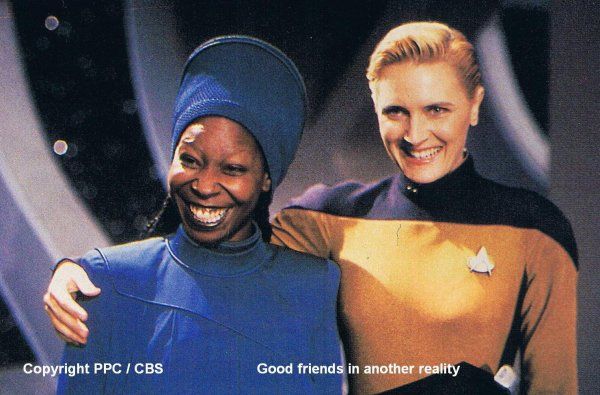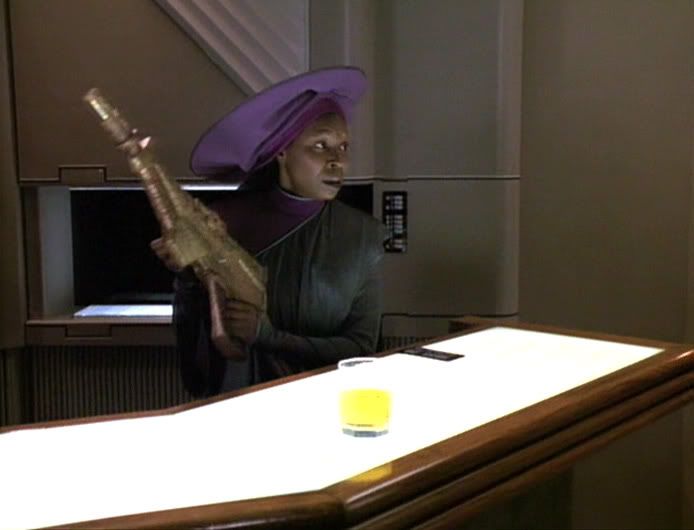@ Quinn TV
I was merely trying to express that "the" Guinan we see in the alternate reality is not "ours". It is not like in a mirror universe episode that the knowledge and experience of "our" Guinan has transferred to the one of the alternate reality. This one has a different knowledge and experience with the crew members of the "Battleship"
Enterprise:
GUINAN:
I don't have alternate biographies of the crew. As I said to the captain, it's just a feeling.
TASHA:
But there's something more when you look at me, isn't there? I can see it in your eyes, Guinan. We've known each other too long.
GUINAN:
We weren't meant to know each other at all. At least, that's what I sense when I look at you. Tasha, you're not supposed to be here.
Here is the next part. Putting it into final form, getting the illustrations together and keeping up with the correspondence between some of the involved parties (elsewhere) has kept me from posting it earlier:
Part III – Alternate Universes
The existence of multiple, alternate universes was established in “Parallels”. In one universe Captain Picard had not survived events in “Best of Both Worlds” but the Borg cube had been defeated, in another one the Borg where everywhere etc.
Apparently, what we see in “Yesterday’s Enterprise” is an alternate future because the protagonists do not refer to properties of the temporal rift other than being a gateway between past and present. But they don’t or can’t exclude that it also connects parallel universes and that the event (an
Enterprise-C travelling to the future) occurs simultaneously in several of these (like all the Worfs in “Parallels” returning from the Bat’leth competition on Forcas III). Ironically, it’s not the present of this alternate reality that suggests an alternate universe but its past we get a glimpse of, i.e. the year 2344 aboard this
Enterprise-C.
- Exhibit A: The explosion of the Klingon Praxis moon in ST VI contributed to the Starfleet’s commander in chief estimation that “the Klingon Empire has roughly 50 years of life left.” A weakened empire could have encouraged Romulan warbirds to attack Klingon outposts like the one near Narendra III. Whether this was a stealth attack hoping to frame the Federation (which I think it was) or an open attack which discouraged the Federation from signing a treaty with the Klingons (which could have drawn the Federation into a Klingon-Romulan war) and was enough casus belli for the Klingons to start a war with the Federation (and not the Romulans?) is not important. What matters is the capability of the Klingons to bring the mighty United Federation of Planets to its feet which begs for explanation unless this is an alternate universe with a much, much weaker Federation in the first place.
- Exhibit B: The one all-too-obvious discrepancy (even for a casual Star Trek viewer) is the lack of uniform chest insignias with Lieutenant Richard Castillo, last surviving senior officer of the Enterprise-C, being the proverbial sore thumb sticking out. He is the main protagonist from that era with the most onscreen time, yet neither wears chest or belt buckle insignia. In our universe Starfleet uniforms had chest insignias in the 23rd Century and continue to do so in the 24th. It stands to reason that we could or should have expected the same for the earlier 24th Century (especially since it is the Starfleet insignia introduced in ST II and there should have been plenty of leftovers in Paramount’s storage). It is evident that only the ship’s commander (first Garrett, then Castillo) is entitled to wear the (combadge) insignia, but not the last senior officer and definitely not the crewmen (in whose cases the belt buckle substitutes the chest insignia). While the crew of the Enterprise-D wears belts with an insignia in addition to the chest insignia which looks like a continuation of the late 23rd Century uniform style (Starfleet belt buckle and chest insignia), the uniforms of the crew of the Enterprise-C lack congruence and continuity. Assuming Kirk’s wraparound tunic was the uniform fashion in an alternate universe (only belt insignias) and the chest insignia was eventually added around 2344 for command officers until both were combined in the present “universe at war” looks like a more believable uniform evolution.

- Exhibit C: The strange lack of insignias on Lt. Castillo’s uniform is somewhat compensated by him being the only crew member of the Enterprise-C seen wearing a sidearm / phaser. While not unusual in the present “universe at war” (Tasha Yar probably suggested “When in Rome, do as the Romans”), there was nevertheless no scene in the episode requiring him to use it and from a production point of view wearing phasers are impractical, in the worst case costly (these phasers have the tendency to fall off and could ruin a whole scene, like it almost did in “Space Seed” when Kirk was smashing the glass of Khan’s suspended animation container – the more interesting aspect of this scene, however, is the good doctor’s reaction to it…). Unless, of course, it was a deliberate “suggestion” by the producers, knowing how obsessive Star Trek fans can get over such details (like this one). The last time we saw lieutenants on an older Enterprise wearing a phaser like Lt. Castillo on the bridge of a starship was in an alternate universe – the universe of “Mirror, Mirror” to be exact.
- Exhibit D: If wearing a phaser on the bridge of a starship isn’t really an unusual thing, then it is definitely the kind of type 2 phaser Lt. Castillo is wearing: It’s unmistakable the TMP era type 2 phaser, almost 80 years old by the time of the Battle of Narendra III !

ST V – TFF was released many months before this TNG episode aired and featured
the latest type 2 phasers 23rd Century technology had to “offer”.
The producers’ decision
not to use this phaser for the year 2344, but instead the oldest phaser type 2 model there was, just preceded by the TOS phaser (!) – add to this what must otherwise be an obvious (even for Rick Berman) production screw-up in regard to Castillo’s missing uniform insignia throughout shooting – rather suggests a deliberate hint that things could be interpreted quite differently than what the episode suggests at a first glance.
Thus, it’s fair game and appropriate to wonder whether this
Enterprise-C really come from the past of “our” known Star Trek Universe - or instead another one, but which exactly?
Is “Yesterday’s Enterprise” alternate reality the mirror universe?
Although the alternate reality has the ingredients that could suggest the mirror universe (
Enterprise-D is not a ship of exploration but of war, the Klingon Empire is about to conquer the Federation, wearing phasers on the bridge is common), the alternate reality lacks one important feature: The personalities, experience and minds of “our” TNG protagonists have not transferred into the bodies of their mirror universe counterparts. The “universe at war” Picard has extensive strategic knowledge of how the war is going in this reality and nobody ever wonders why Tasha Yar is there, except, of course, for Guinan (We’ll get to her in the last part).
Is “Yesterday’s Enterprise” alternate reality an alternate universe?
What we saw in „Yesterday’s Enterprise” was rather an alternate universe, where the
Enterprise-C had not defended the Klingon outpost at Narendra III which resulted in the future and reality we saw there.
The Klingon Empire’s strength, to bring the United Federation of Planets to its feet within 20 years, could be owed to the fact that the moon Praxis never exploded in this alternate universe and/or certain historical key events turned out differently or simply did not happen and in total favored the Klingon Empire at the expense of the UFP.
Quite possibly Sternbach’s Ambassador Class design exists in multiple universes (as does Probert’s Galaxy Class design), but apparently the
Enterprise-C in “Yesterday’s Enterprise” came from a time-line and universe that was lagging behind “ours” in terms of technological progress - hence TMP phasers still in use in the 24th Century, old fashioned late 23rd Century style combadges (compared to the
modern one worn by Wesley’s father at about the same time in our universe and generally available to lieutenants), a shortage of the aforementioned items … and eventually a ship class chosen for “their”
Enterprise-C which had already been surpassed by Andrew Probert’s design in “our” universe.
(alternate universe treknological evolution schematic to follow soon)
To be continued in Part IV (Tasha Yarn)…stay tuned
Bob







 ) question:
) question:
 Maybe Picard just decided he didn't like how the wall looked and thus ordered it replaced.
Maybe Picard just decided he didn't like how the wall looked and thus ordered it replaced.